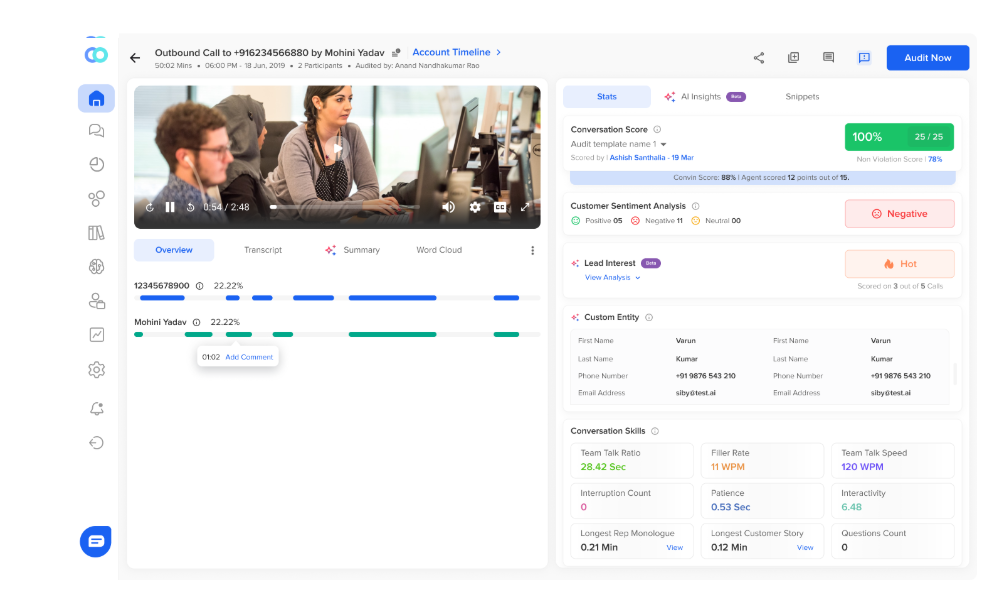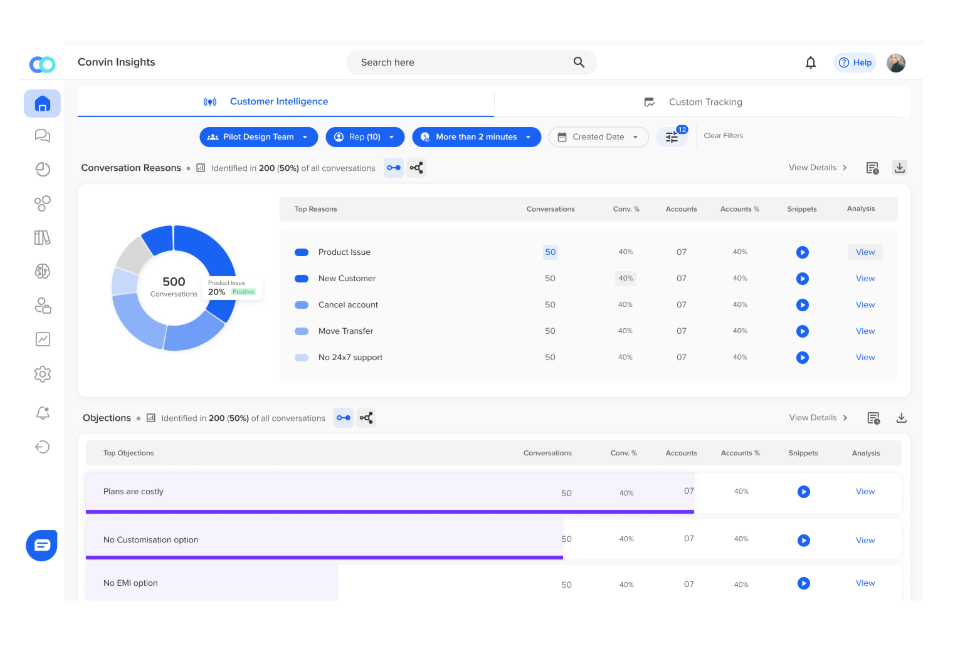Machine learning in banking is no longer a futuristic idea; it’s a strategic response to rising risk, fraud, and regulatory pressure. Banks today face a complex landscape where manual processes fall short in detecting threats and ensuring compliance.
To solve this, leaders are turning to intelligent technologies that offer speed, scale, and smarter decision-making.
Machine learning in banking helps financial institutions automate fraud detection, monitor compliance, and enhance efficiency at scale.
The problem lies in growing risk complexity and regulatory scrutiny. Platforms like Convin provide real-time solutions by embedding AI into banking workflows, making oversight smarter and scalable.
In this blog, we’ll explore how banks can leverage machine learning in banking to control risk and drive efficiency, and how Convin is already transforming outcomes. Let’s dive in.
Audit omnichannel conversations with Convin automation.
Industry Challenges That Machine Learning in Banking Can Solve
Machine learning in banking addresses critical industry pressures from regulatory scrutiny to fraud threats and operational inefficiencies. Traditional systems are buckling under high-volume compliance demands, exposing banks to increased risk. Let’s delve deeper into how these challenges necessitate AI-driven transformation.
Rising Compliance Pressure In Banking
Compliance in banking has become more demanding, dynamic, and challenging to manage manually. With regulations intensifying globally, banks face growing scrutiny over every customer interaction.
Machine learning in banking is emerging as a vital tool to meet these rising compliance expectations head-on.
- Regulatory mandates now demand stricter oversight of misselling, KYC violations, and agent behavior across all channels.
- Legacy manual QA processes often audit less than 5% of interactions, creating blind spots and oversight risks.
- Cross-border banking regulations complicate oversight, mandating scalable and intelligent monitoring.
- Manual audits are costly, time-consuming, and inconsistent, exposing banks to penalties and reputational damage.
- Escalation handling is slow and reactive without real-time insight into agent conduct or conversation sentiment.
These pressures make the adoption of machine learning in banking not just advantageous but essential for strategic risk control.
Fraud Detection In Banking Is Evolving
Fraud detection in banking has outgrown rule-based systems that rely on static patterns and historical data. Today’s threats are dynamic, spreading across digital, voice, and behavioral channels, which requires smarter tools.
Machine learning in banking offers the speed and adaptability needed to detect fraud in real time.
- Fraudsters are leveraging sophisticated schemes, social engineering, and synthetic identities that outpace rule-based systems.
- Static detection systems lack real-time adaptability, often leading to hundreds of false positives per day.
- Machine learning in banking enables dynamic anomaly detection across multimodal input, such as voice, chat, and transaction logs.
- Banks must proactively model fraud patterns to keep pace with evolving methods, rather than merely reactivating old rules.
- Delay in detection costs money, reputation, and customer trust; AI fraud detection offers faster, richer insights.
Fraud detection in banking has evolved beyond traditional thresholds, making intelligent systems indispensable.
Now that we’ve explored the core challenges, let’s examine how Convin harnesses machine learning in banking to address them head-on.
Get full audit visibility with Convin’s auto-scorecards.
Smarter Banking Outcomes With Machine Learning And Convin
Machine learning in banking becomes operational and transformative when embedded into platforms like Convin. Convin applies AI and conversation intelligence to target misselling, compliance breaches, and agent performance. Here’s a deeper dive into how Convin operationalizes machine learning use cases in banking.

Convin’s Role In Machine Learning Use Cases In Banking
Machine learning in banking becomes truly impactful when paired with the right platform, and that’s where Convin excels.
Explicitly designed for regulated industries, Convin delivers real-time insights, compliance automation, and agent support at scale.
Let’s explore how Convin brings high-impact machine learning use cases in banking to life.
- Convin ensures 100% audit coverage of every call, chat, and email, eliminating manual bias and inconsistencies.
- Real-time Agent Assist monitors conversations live, prompting agents with actionable script reminders and compliance checks.
- Supervisor Assist provides managers with real-time visibility, enabling barge-ins and violation interventions instantly.
- Automated scorecards, dashboards, and generative feedback streamline quality assurance, reducing manual intervention.
- Convin’s LLM-powered knowledge base helps agents with first-call resolution, aligning with machine learning in banking best practices.
Through these capabilities, Convin exemplifies how machine learning in banking can be integrated pragmatically into contact center operations.
Data By Machine Learning Techniques Powering Convin
Behind every effective AI solution lies high-quality, well-modeled data, and Convin is no exception.
This section explores how Convin uses data by machine learning techniques to deliver real-time insights and regulatory assurance.
From speech analytics to behavioral scoring, here’s what powers its intelligent outcomes.
- NLP-driven speech and text analysis parses sentiment, compliance flags, and agent intent.
- Custom scorecards capture granular metrics, such as talk time, filler usage, sentiment, and talk-to-listen ratios.
- Automated PII masking ensures privacy compliance under GDPR, PCI DSS, HIPAA, and RBI standards.
- Integration with CRM systems and dashboards empowers leaders with omnichannel, real-time performance visibility.
- Generative AI aids coaching via instant feedback and knowledge retrieval, supporting machine learning use cases in banking.
Convin’s robust data pipeline demonstrates how data, analyzed by machine learning techniques, delivers nuanced, actionable insights across risk and performance domains.
With capabilities mapped, let’s now examine the tangible outcomes and evidence of machine learning in banking adoption.
Track risky conversations using NLP and speech analytics.
This blog is just the start.
Unlock the power of Convin’s AI with a live demo.

Proof That Machine Learning in Banking Delivers Results
Real-world performance gains validate machine learning in banking, and Convin’s impact is clear across metrics. These proof points will resonate with leaders focused on measurable ROI and risk reduction.
Evidence Of AI Fraud Detection And Operational Impact
Fraud detection in banking has become more complex, faster-moving, and costly to ignore. Machine learning in banking is stepping in to deliver predictive accuracy and operational resilience.
Let’s examine the real-world impact of AI fraud detection and its measurable outcomes.
- Banks report a 31% reduction in misselling incidents, 38% fewer compliance violations, 36% lower escalations, a 28% improvement in AHT, a 29-second boost in CSAT, and a 23% revenue uplift.
- Real-time Agent Assist usage accelerates onboarding speed and intensifies audit readiness.
- Automated monitoring shortens audit prep cycles and embeds compliance into everyday operations.
These outcomes make a compelling case for machine learning in banking as a value driver, not just an innovation.

Convin Case Study: Misselling And Compliance
Misselling remains one of the most sensitive compliance issues in banking, attracting heavy regulatory penalties.
Manual audits barely scratch the surface, often missing key violations across customer interactions. This case study reveals how Convin applied machine learning in banking to solve this challenge at scale.
- Real-time monitoring via Convin reduced misselling by 31% and compliance violations by 38%, with full monitoring coverage.
- Escalations declined by 36%, while AHT improved by 28%; CSAT jumped by 29 seconds.
- Revenue rose by 23%, demonstrating that compliance and efficiency gains also fuel top-line growth.
This case illustrates how machine learning in banking, as exemplified by Convin, has a multifaceted impact across various operations.
Author’s Expert Opinion:
As someone analyzing AI adoption in BFSI for years, I’ve seen machine learning in banking move from hype to operational necessity. Banks that prioritize AI integration today are future-proofing their institutions; those that delay are choosing vulnerability.
Armed with results, let’s evaluate the broader benefits and the critical safeguards when deploying machine learning in banking.
Improve advisor oversight using Convin’s machine learning in banking.
Benefits, Drawbacks, And Tools Of Machine Learning in Banking
While promising, machine learning in banking requires balanced integration that respects governance, ethics, and technological finesse.
Benefits Of Machine Learning Use Cases In Banking
Machine learning use cases in banking are reshaping how financial institutions operate, analyze, and make decisions.
These benefits go far beyond automation; they impact fraud detection, compliance, and customer experience in measurable ways.
Here’s a breakdown of the most valuable outcomes banks can expect.
- Enhanced fraud detection in banking via real-time, adaptive model-based monitoring.
- Automated QA elevates agent performance, onboarding speed, and customer satisfaction.
- Compliance monitoring scales cost-effectively and supports audit-readiness across voice, chat, and email.
These benefits confirm that machine learning in banking is a strategic multibagger impacting risk, revenue, and resilience.
Machine Learning In Investment Banking
Investment banking functions like risk modeling, M&A advisory, and trading require intelligent data-driven decisions at scale. Machine learning in investment banking enhances accuracy, prediction, and automation across high-stakes functions. Here’s how it supports executive needs and ties into the broader rise of AI in banking.
- Machine learning in investment banking improves market risk prediction through advanced time-series forecasting.
- AI-driven models assist in valuation modeling, automating scenario analysis, and portfolio simulations.
- Natural language processing helps analyze earnings calls, news sentiment, and market events in real-time.
- AI in banking platforms like Convin applies call analysis to investment advisor interactions for compliance.
- Automated QA ensures advisors stay aligned with internal policies and regulatory frameworks.
Incorporating machine learning in investment banking enables smarter decisions, faster modeling, and lower regulatory risk. It bridges front-office performance and back-office control, delivering a full-stack AI upgrade for investment banks.
Challenges And Risks To Watch
While machine learning in banking offers unmatched efficiency and insight, its deployment comes with real-world risks.
From data governance issues to ethical pitfalls, banks must navigate these challenges with caution and clarity. Understanding these risks is essential to unlocking sustainable, compliant AI transformation.
- Complex AI/ML models, especially black-box types, raise regulatory and explainability concerns.
- Model risk, such as bias, drift, or performance degradation, mandates robust governance frameworks.
- Ensuring compliance with evolving AI regulations requires proactive risk audit and transparency.
Navigating these challenges ensures that machine learning in banking remains sustainable, transparent, and trustworthy.
Finally, let’s consolidate these insights and make the case for leadership-driven adoption of machine learning in banking and Convin.
Align frontline behavior with Convin’s QA checks.
Machine Learning in Banking for Smarter Risk Control
Machine learning in banking has matured from novel to necessary, enabling smarter risk mitigation and operational intelligence. Convin’s robust, real-time solution brings this evolution into boardroom-relevant action. Senior leaders must integrate AI to safeguard, scale, and strategically steer modern banking operations.
- Convin enables 100% conversational oversight, boosting compliance, reducing escalation, and preserving brand integrity.
- Its Gen‑AI-backed coaching, reporting, and QA ecosystem delivers immediate, measurable performance and risk payoffs.
- For C‑suite decision-makers, Convin represents a high-velocity path from risk exposure to ROI and resilience.
The deployment of machine learning in banking via Convin is not a pilot; it’s the next imperative for future-ready financial institutions.
Schedule your Convin demo now!
FAQs
What are the 4 types of machine learning?
The four types of machine learning are supervised learning, unsupervised learning, semi-supervised learning, and reinforcement learning. In machine learning in banking, supervised and reinforcement learning are commonly used for real-time decision-making.
Which AI is used in banking?
AI in banking includes natural language processing (NLP), machine learning, and predictive analytics. These technologies power fraud detection in banking, compliance checks, and customer service automation. Solutions like Convin apply AI in banking to enable full-scale audits, real-time alerts, and customer insights.
What kind of machine learning is used in finance?
Machine learning in banking and finance includes classification models, anomaly detection, and time-series forecasting. These help predict credit risk, detect fraud, and automate investment strategies. Data by machine learning techniques ensures models adapt to evolving market conditions.
What is the best AI for finance?
The best AI for finance depends on the use case, such as compliance, trading, or customer experience. For risk and compliance, platforms like Convin deliver exceptional ROI by embedding machine learning in banking workflows. It automates audits, reduces regulatory exposure, and improves decision-making across channels.









.avif)